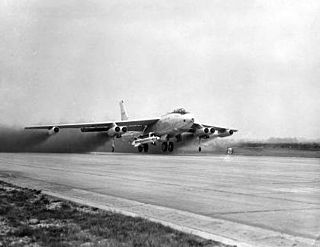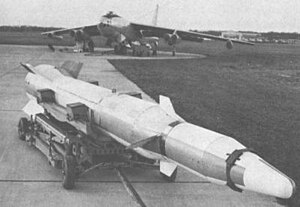
The de Havilland Propellers Blue Streak was a British Intermediate-range ballistic missile (IRBM), and later the first stage of the Europa satellite launch vehicle. Blue Streak was cancelled without entering full production.

A missile is an airborne ranged weapon capable of self-propelled flight aided usually by a propellant, jet engine or rocket motor.

The Douglas GAM-87 Skybolt was a hypersonic air-launched ballistic missile (ALBM) developed by the United States during the late 1950s. The basic concept was to allow US strategic bombers to launch their weapons from well outside the range of Soviet defenses, as much as 1,000 miles (1,600 km) from their targets. To do this in an air-launched form, a lightweight thermonuclear warhead was needed. Initially, the W47 from the Polaris missile was selected, but it was later replaced by the W59 from the Minuteman missile.

Anti-satellite weapons (ASAT) are space weapons designed to incapacitate or destroy satellites for strategic or tactical purposes. Although no ASAT system has yet been utilized in warfare, a few countries have successfully shot down their own satellites to demonstrate their ASAT capabilities in a show of force. ASATs have also been used to remove decommissioned satellites.
Lockheed Martin Space is one of the four major business divisions of Lockheed Martin. It has its headquarters in Littleton, Colorado, with additional sites in Valley Forge, Pennsylvania; Sunnyvale, California; Santa Cruz, California; Huntsville, Alabama; and elsewhere in the United States and United Kingdom. The division currently employs about 20,000 people, and its most notable products are commercial and military satellites, space probes, missile defense systems, NASA's Orion spacecraft, and the Space Shuttle external tank.

An air-to-surface missile (ASM) or air-to-ground missile (AGM) is a missile designed to be launched from military aircraft at targets on land or sea. There are also unpowered guided glide bombs not considered missiles. The two most common propulsion systems for air-to-surface missiles are rocket motors, usually with shorter range, and slower, longer-range jet engines. Some Soviet-designed air-to-surface missiles are powered by ramjets, giving them both long range and high speed.

The ASM-135 ASAT is an air-launched anti-satellite multistage missile that was developed by Ling-Temco-Vought's LTV Aerospace division. The ASM-135 was carried exclusively by United States Air Force (USAF) F-15 Eagle fighter aircraft.
On 11 January 2007, China conducted an anti-satellite missile test. A Chinese weather satellite—the FY-1C polar orbit satellite of the Fengyun series, at an altitude of 865 kilometres (537 mi), with a mass of 750 kilograms (1,650 lb)—was destroyed by a kinetic kill vehicle traveling with a speed of 8 km/s (18,000 mph) in the opposite direction. It was launched with a multistage solid-fuel missile from Xichang Satellite Launch Center or nearby.

An air-launched ballistic missile (ALBM) is a ballistic missile launched from an aircraft. An ALBM allows the launch aircraft to stand off at long distances from its target, keeping it well outside the range of defensive weapons like anti-aircraft missiles and interceptor aircraft. Historically, once launched the missile was essentially immune to interception due to a lack of capable anti-ballistic missiles, with those few that did exist being limited to known static positions. This combination of features allowed a strategic bomber to present a credible deterrent second-strike option in an era when improving anti-aircraft defences appeared to be rendering conventional bombers obsolete. However, by the 1990s surface-to-air missile technology had innovated to the point of allowing the interception of such weapons from road mobile systems, albeit at a lower PoK. By the early 21st century capable, dedicated, ABM systems from several nations had been deployed in significant numbers, spurring further innovation in hypersonic glide vehicles to penetrate such systems and keep ballistic missiles capable.
The Thor DSV-2 was a series of sounding rockets, test vehicles, and anti-satellite weapons derived from the Thor Intermediate-range ballistic missile. It was also used as the first stage of several Thor-derived expendable launch systems.

The High Virgo, also known as Weapons System 199C (WS-199C), was a prototype air-launched ballistic missile (ALBM) jointly developed by Lockheed and the Convair division of General Dynamics during the late 1950s. The missile proved moderately successful and aided in the development of the later GAM-87 Skybolt ALBM. It was also used in early tests of anti-satellite weapons.

The Alpha Draco missile, also known as Weapons System 199D (WS-199D), was an experimental ballistic missile developed by McDonnell Aircraft in the late 1950s to investigate the aerodynamic physics of the boost-glide reentry trajectory. Three test flights were conducted in 1959, of which two were successful.

Weapons System 199 (WS-199) was a weapons development program conducted by the United States Air Force to research and develop new strategic weapons systems for Strategic Air Command. Two air-launched and one ground-launched vehicles were developed as part of the program. While none entered production, they assisted in the development of both the GAM-87 Skybolt air-launched ballistic missile and that of re-entry vehicles for ballistic missiles.
The Diamondback was a proposed nuclear-armed air-to-air missile studied by the United States Navy's Naval Ordnance Test Station during the 1950s. Intended as an enlarged, nuclear-armed version of the successful Sidewinder missile, Diamondback did not progress beyond the study stage.

The ascent propulsion system (APS) or lunar module ascent engine (LMAE) is a fixed-thrust hypergolic rocket engine developed by Bell Aerosystems for use in the Apollo Lunar Module ascent stage. It used Aerozine 50 fuel, and N
2O
4 oxidizer. Rocketdyne provided the injector system, at the request of NASA, when Bell could not solve combustion instability problems.

The AAM-N-5 Meteor was an early American air-to-air missile, developed by the Massachusetts Institute of Technology and Bell Aircraft for the United States Navy. Initially, both air-launched and ship-launched versions were considered. Versions designed for launch from carrier-based aircraft proceeded to the flight testing stage before the project was cancelled.

Non-ballistic atmospheric entry is a class of atmospheric entry trajectories that follow a non-ballistic trajectory by employing aerodynamic lift in the high upper atmosphere. It includes trajectories such as skip and glide.

Jaguar was a three-stage sounding rocket developed by the United States Air Force in the early 1960s. Designed for air launch to allow soundings from remote areas without infrastructure, it was only launched twice before the project was abandoned.
Weapon System 124A, given the codename Flying Cloud, was a project of the United States Air Force to use high-altitude balloons to deliver bombs and weapons of mass destruction on enemy targets. Tested in late 1954, the project was found to be unfeasible from the standpoint of accuracy, and the project was terminated the following year.

On 27 March 2019, India tested an anti-satellite weapon (ASAT) during an operation code named Mission Shakti. The target of the test was a satellite present in a low Earth orbit, which was hit with a kinetic kill vehicle.
















